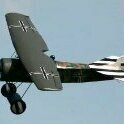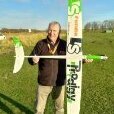-
Posts
379 -
Joined
-
Last visited
Recent Profile Visitors
Mike Chantler's Achievements
167
Reputation
-
Mike Chantler started following A bigger foamboard build - Miles Hawk Speed Six and 1/6 Westland Whirlwind
-
Mike Chantler started following Gliders and Gliding - General Discussion and Slope Soaring and Dynamic Soaring
-
Mike Chantler started following Building Board - Construction Advice. , How rough a flying field can you fly from , The joy of slope and 3 others
-

How rough a flying field can you fly from
Mike Chantler replied to Adrian H's topic in All Things Model Flying
Depends on how 'rough' it is. Main thing is to check that there are no ocaisional rocks, fence posts etc. It's surprising how often the odd one jumps up and hits the nose of a belly landing 🙂 -

Hybrid 60" Plank
Mike Chantler replied to Mike Chantler's topic in Slope Soaring and Dynamic Soaring
Used tapped hardwood + 4mm bolt 4mm CF tube stopped the drill from wandering. Epoxy in base of fin was laziness - should of used CF sheet or ply which would of been just as quick and lighter! -

Hybrid 60" Plank
Mike Chantler replied to Mike Chantler's topic in Slope Soaring and Dynamic Soaring
So as a first step in 'streamlining' I decided to add airfoil NACA 9% fin. I'd dithered about this because I could not think of a simple, strong way of attaching the airfoil section to the 4mm slot for the old tail. It then occurred to me that I could simply alter the 3D model to accept the new shape, duh! So cut foam and laminated in 0.5 mm veneer. Could not be bothered with bagging so used 20kg weights - much less than equivalent of bagging and mostly successful (a little bit of lifting on LE). Added unidirectional carbon across veneer grain for TE - seems to work really well 🙂 White glue for top and LE balsa (gripped enough to sand a couple of hrs later - so may use this rather than contact in future 🙂 ) Used 6.5g epoxy mix and weight ended up same as correx fin 🙂 -
Interesting article @https://www.mh-aerotools.de/airfoils/linkage.htm on wind tunnel tests of linkages. suggests that it's always best to shroud them
-

Hybrid 60" Plank
Mike Chantler replied to Mike Chantler's topic in Slope Soaring and Dynamic Soaring
Flew well today 😊 but the correx tail nearly came off each time I landed, and then I noticed on one launch that only the front of the fin was secured 🤫 Hence bit of yellow tape. Flying slightly nose heavy as intended for peace of mind on maiden. Seems very smooth 🙂 Will try and add a bit of stream lining over the next few weeks and see if I notice any difference 🙂 -
Thanks Konrad, think I'll experiment with a tape style cover for the gap and moulding some small linkage covers - I seem to remember seeing an analysis somewhere that even larger exit shrouds provide less drag than exposed linkages. I'll have a look at Martin Hepperle's pages again and do a bit more research to see if I can understand them more (!) Your point about stiffness is not one I had considered: caused me to look at the correx fin - it has already warped a bit and will likely cause increased drag from both fin and a skidding fuselage. A friend also thought that flat plate tails can accentuate the tail jitter that you sometimes get on planks. This thread also made me think what I wanted out of this model: which is I'd like better energy retention, so that in towards marginal conditions, it will still perform aerobatic manoeuvres. I'm not so bothered about weight per se. Of course someone might rightly point out that if I wanted energy retention I should fly mouldies, I have a number hiding in my garage, but I'm an indifferent pilot and their speed and relative fragility tend to make me a nervous!
-
Really interesting series of posts - very enlightening, especially stuff on non-linear relationships - much appreciated 👍as I have been pondering adding more streamlining and realised I don't have a clue as to what may be beneficial in the weight/streamlining trade-off 🤔 So being very selfish I'd like to know what folk think about four options on a recently completed build. Options are: 1. exit linkage shrouds or covering up as much of the exit holes as possible: 2. Putting some sort of wiper over the 4mm top elevon gap (they are bottom hinged and just about full length) 3. Covering the veneered wings completely vinyl or similar (currently have 3 coats of water-based acrylic). 4. changing the fin to an aerofoil (say 10% symmetric section) For context it's a 60" 8.9% PW51 airfoil plank. Weight is currently a little over 1000g, ballast can add up to 750g, and i'm expecting to fly it in 15-40mpm winds up the hill, normally on a little over half ballast. The airfoil section is pretty accurate except the TE does not go below 1mm thickness at the end for ding protection. @Konrad I hope you don't feel i have hijacked your thread with such specific requests, but any pointers, suggestions would be very much appreciated. Mike
-

Hybrid 60" Plank
Mike Chantler replied to Mike Chantler's topic in Slope Soaring and Dynamic Soaring
Balanced and empty, it came out at 1045g. That's 75g lighter than the glass wing and circa 175g heavier than the lam wing. However, it feels much stiffer than both and much more ding resistant. It still needs vinyl decoration so I can see which way up it is! But the main differences are that the ailerons are 25% larger than the previous version and are much closer to the PW51 section. So, needs decoration and rates sorted but then should be ready for an outing on Sunday. -

Building Board - Construction Advice.
Mike Chantler replied to Nigel Heather's topic in All Things Model Flying
I use plasterboard on top of a heavy steel framed table, even so I have noticed that the table has bowed ever so slightly when I stick a meter rule on top. I slide sheets of a5 or a4 paper under the gap one at a time then transfer to under the middle of the plasterboard. This may seem a bit extreme, but ccaisonally I use it to bag foam veneered wings with live hinges (even slight bowing gives ailerons that behave very oddly). The plasterboard never lasts more than one build but it's cheap 😀 I like the sound of the Sundeala though, never tried that. 👍 -

Hybrid 60" Plank
Mike Chantler replied to Mike Chantler's topic in Slope Soaring and Dynamic Soaring
Drilled and tapped bolt holes - epoxy/hardwood worked well - very easy compared to Mk4 mess. No idea why I used different sized bolts, from a crash I know that a 4mm bolt at the front would be fine! Hot-melted aileron sub edges Servo mounts and cables in 🙂 And added 25gsm glass over tips to help their ding resistance 🙂 Getting near finished 🙂 🙂 🙂 -

Hybrid 60" Plank
Mike Chantler replied to Mike Chantler's topic in Slope Soaring and Dynamic Soaring
Just started on under/over linkages Servo frames were too good a fit(!!) and would not release servos once they were in the wing so had to dremel a bit of clearance. Carbon tops and bottoms add 2 x 0.3 mm so had to adjust height. And put lead exit hole in wrong place initially! But mega-chuffed with the way they have worked out 🙂😁 -

Hybrid 60" Plank
Mike Chantler replied to Mike Chantler's topic in Slope Soaring and Dynamic Soaring
Added 1oz aramid wing bandage as there is very little room for anything thicker, we'll see if this is strong enough when it flies! Started scary part: cutting/hinging the ailerons, followed Speedsterden vid on RCgroups ArtHobby thread this time. Liked the clearance the hacksaw gave at the ends but they needed tidying up a bit (tape does help stop the tear-out). Cutting from the non-hinge side first definitely made aligning hinge and top-cuts easier 🙂 And I really liked the idea of using a blade with the tip ground off to stop it damaging the thin aramid hinge. 🙂 -

Hybrid 60" Plank
Mike Chantler replied to Mike Chantler's topic in Slope Soaring and Dynamic Soaring
Used 3 coats Hycote spray lacquer on aileron areas, predicably this stuff destroyed test foam when sprayed really close, but did not get though veneer when sprayed 2 passes x3 @ 8". However, it did not prevent brush-on water-based acrylic curling test piece(maybe didn't leave spray to dry long enough). Used the brush-on stuff for the rest of the wing as I got really bored/frustrated using the spray.🙄 For the first time I used gradually increasing grits as all the videos tell you too - made the process real quick - duh, should of been doing this years ago 🤔🙂 -

Glueing Control Surface Hinges and Horns??
Mike Chantler replied to Witterings's topic in All Things Model Flying
I agree, por is a contact adhesive, works well if used as thin film on foam and allow to dry. If it's thick it takes longer to dry and is 'elastic' making it difficult to sand. -

Hybrid 60" Plank
Mike Chantler replied to Mike Chantler's topic in Slope Soaring and Dynamic Soaring
Slow progress as have been faffing around a bit. Getting near to varnishing stage, so as the ailerons are pretty thin I've been looking at the effect of varnishes on veneer: Water-based varnish definitely makes it curl! 😮I may well use a solvent based varnish on the wings - but will need to watch I don't melt the foam! I also experimented with shaping hardwood to fit the void above and below the front biscuit, decided this was a bad idea as no matter how careful I tended to distort the unsupported skins a wee bit, so filled them with 20 min epoxy instead (potentially very messy even if you use using syringes etc.) The thing I really didn't like was that even the epoxy tended to distort the skins a little (1/2 mm or so) - not a big deal until you come to join the wings and you are using the edges of root sections as the datum 😞 I did have the beds but like to use the root sections to double check by running a finger across the seam. Nearly forgot the dihedral brace as I was putting it all together! We'll see if the wings each now have the same AOA on its maiden!




